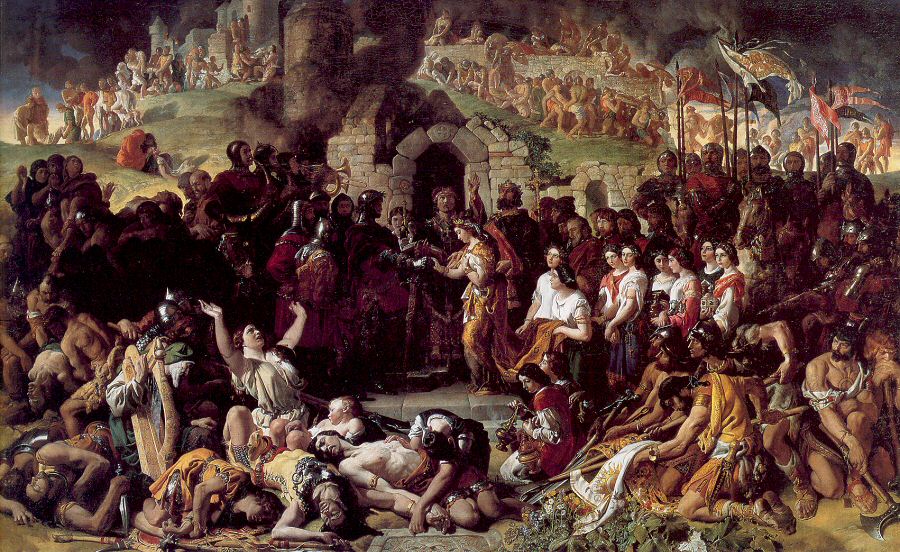|
Anglo-Normans
The Anglo-Normans ( nrf, Anglo-Normaunds, ang, Engel-Norðmandisca) were the medieval ruling class in England, composed mainly of a combination of ethnic Normans, French, Anglo-Saxons, Flemings and Bretons, following the Norman conquest. A small number of Normans had earlier befriended future Anglo-Saxon king of England, Edward the Confessor, during his exile in his mother's homeland of Normandy in northern France. When he returned to England some of them went with him, and so there were Normans already settled in England prior to the conquest. Edward's successor, Harold Godwinson, was defeated by Duke William the Conqueror of Normandy at the Battle of Hastings, leading to William's accession to the English throne. The victorious Normans formed a ruling class in Britain, distinct from (although inter-marrying with) the native populations. Over time their language evolved from the continental Old Norman to the distinct Anglo-Norman language. Anglo-Normans quickly establ ... [...More Info...] [...Related Items...] OR: [Wikipedia] [Google] [Baidu] |
Norman Conquest Of Ireland
The Anglo-Norman invasion of Ireland took place during the late 12th century, when Anglo-Normans gradually conquered and acquired large swathes of land from the Irish, over which the kings of England then claimed sovereignty, all allegedly sanctioned by the Papal bull '' Laudabiliter''. At the time, Gaelic Ireland was made up of several kingdoms, with a High King claiming lordship over most of the other kings. The Norman invasion was a watershed in Ireland's history, marking the beginning of more than 800 years of direct English and, later, British, involvement in Ireland. In May 1169, Anglo-Norman mercenaries landed in Ireland at the request of Diarmait mac Murchada (Dermot MacMurragh), the deposed King of Leinster, who sought their help in regaining his kingship. They achieved this within weeks and raided neighbouring kingdoms. This military intervention was sanctioned by King Henry II of England. In return, Diarmait had sworn loyalty to Henry and promised land to the Norm ... [...More Info...] [...Related Items...] OR: [Wikipedia] [Google] [Baidu] |
Cambro-Normans
Cambro-Normans ( la, Cambria; "Wales", cy, Normaniaid Cymreig; nrf, Nouormands Galles) were Normans who settled in southern Wales, and the Welsh Marches, after the Norman invasion of Wales, allied with their counterpart families who settled England following its conquest. Usage in Ireland Some Irish historians prefer to use this term instead of Anglo-Norman because many of the knights who invaded Ireland in 1170, such as the FitzGeralds, originated and settled in modern-day Wales, following the Norman conquest. South Wales was under Franco-Norman, Plantagenet control at this point in history and the Cambro-Normans living in south Wales owed their allegiance to the Le Mans born Henry II, not a native Welsh prince, therefore are often confused with Anglo-Normans, due to their allegiance. Contemporary Irish accounts of this period erroneously called the incomers ''Saxain'', which means "Saxon", i.e. "English". The term Cambro-Norman is rarely used even in Ireland, and th ... [...More Info...] [...Related Items...] OR: [Wikipedia] [Google] [Baidu] |
Normans
The Normans ( Norman: ''Normaunds''; french: Normands; la, Nortmanni/Normanni) were a population arising in the medieval Duchy of Normandy from the intermingling between Norse Viking settlers and indigenous West Franks and Gallo-Romans. The term is also used to denote emigrants from the duchy who conquered other territories such as England and Sicily. The Norse settlements in West Francia followed a series of raids on the French northern coast mainly from Denmark, although some also sailed from Norway and Sweden. These settlements were finally legitimized when Rollo, a Scandinavian Viking leader, agreed to swear fealty to King Charles III of West Francia following the siege of Chartres in 911. The intermingling in Normandy produced an ethnic and cultural "Norman" identity in the first half of the 10th century, an identity which continued to evolve over the centuries. The Norman dynasty had a major political, cultural and military impact on medieval Europe and the N ... [...More Info...] [...Related Items...] OR: [Wikipedia] [Google] [Baidu] |
Scoto-Norman
The term Scoto-Norman (also Franco-Scottish or Franco-Gaelic) is used to describe people, families, institutions and archaeological artifacts that are partly Scottish (in some sense) and partly Anglo-Norman (in some sense). It is used to refer to people or things of Norman, Anglo-Norman, French or even Flemish or Breton origin, but who are associated with Scotland in the Middle Ages like Scoto-Anglo-Saxon. It is also used for any of these things where they exhibit syncretism between French or Anglo-French culture on the one hand, and Gaelic culture on the other. For instance, the Kings of Scotland between the reign of the David I and the Stewart period are often described as Scoto-Norman. A classic case of Gaelic and French cultural syncretism would be Lochlann, Lord of Galloway, who used both a Gaelic (''Lochlann'') and French name (''Roland''), and kept followers of both languages. Another example of a Scoto-Norman, would be Robert the Bruce. The term is used by historians ... [...More Info...] [...Related Items...] OR: [Wikipedia] [Google] [Baidu] |
Anglo-Norman Language
Anglo-Norman, also known as Anglo-Norman French ( nrf, Anglo-Normaund) (Standard French, French: ), was a dialect of Old Norman French that was used in Kingdom of England, England and, to a lesser extent, elsewhere in Great Britain and Ireland during the Anglo-Normans, Anglo-Norman period. When William the Conqueror led the Norman conquest of England in 1066, he, his nobles, and many of his followers from Normandy, but also those from northern and western France, spoke a range of langues d'oïl (northern varieties of Gallo-Romance languages, Gallo-Romance). One of these was Old Norman, also known as "Old Northern French". Other followers spoke varieties of the Picard language or western register (sociolinguistics), registers of general Old French. This amalgam developed into the unique insular dialect now known as Anglo-Norman French, which was commonly used for literary and eventually administrative purposes from the 12th until the 15th century. It is difficult to know much about ... [...More Info...] [...Related Items...] OR: [Wikipedia] [Google] [Baidu] |


